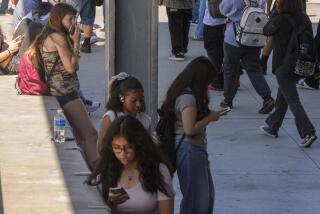Teenage social media butterflies may not be such a bad idea
With his gaze fixed on a tiny screen, hearing plugged by earbuds and fingers flying, the average teenager may look like a disaster in the making: socially stunted, terminally distracted and looking for trouble. But look beyond the dizzying array of beeping, buzzing devices and the incessant multitasking, say psychologists, and today’s digital kids may not be such a disaster after all.
Far from hampering adolescents’ social skills or putting them in harm’s way, as many parents have feared, electronics appear to be the path by which children today develop emotional bonds, their own identities, and an ability to communicate and work with others.
In fact, children most likely to spend lots of time on social media sites are not the least well-adjusted but the healthiest psychologically, suggests an early, but accumulating, body of research.
In one new study, 13- and 14-year-olds were found to interact on social network sites such as Facebook and MySpace simply in ways that were consistent with their offline relationships and patterns of behavior. And of the 86% of children who used social media sites (a number that reflects the national average), participants who were better adjusted in their early teens were more likely to use social media in their early 20s, regardless of their age, gender, ethnicity or their parents’ income.
Adolescents are largely using social networking sites to keep in touch with friends they already know, not to converse with strangers, said the author of that research, University of Virginia psychologist Amori Yee Mikami.
“So parents of well-adjusted teens may have little to worry about regarding the way their children behave when using social media,” Mikami added. “It’s likely to be similarly positive behavior.”
Megan Mills, a Los Angeles eighth-grader, and her mother would agree. Megan cut her digital teeth on the ‘tween social networking site Club Penguin.
Now 14, she has graduated to a Facebook account. She counts her mom among her many “friends” — a status that gives Donna Schwartz Mills access to her daughter’s ongoing electronic chatter and a condition that Mills laid down before allowing her daughter’s foray into teen social networking.
Mills, 54 and herself a blogger, says she’s seen little to fret about — and much to cheer — on her periodic visits to her daughter’s Facebook page. The teen, who has scaled back a once all-consuming commitment to gymnastics, keeps in touch with friends and coaches from that phase of her life, as well as with current friends that Mills knows well.
“People are always worried about the Internet making it easier for strangers to hurt your children,” Mills says. But she points out, “The dangers are the old dangers of who they hang out with.”
In studies of teenagers and young adults, Cal State L.A. psychology professor Kaveri Subrahmanyam has also found that children’s online worlds and friendships strongly resemble their relationships offline, with overlapping casts of characters and similar hierarchies of closeness.
“I think the majority of kids use it in ways that don’t jeopardize their well-being,” she said.
Ultimately, it seems, the digital world is simply a new and perhaps more multidimensional place to conduct the age-old work of adolescence — forming identities separate from those of parents.
Every waking hour
Just how outsized is digital media’s presence in a child’s life? In January, the Kaiser Family Foundation reported that for more than 7 1/2 hours a day, American children ages 8 to 18 are tethered to computers, plugged into MP3 players, watching TV or playing video, computer or handheld games — and for much of that time, doing several at once.
Add to that tally time spent texting by cellphone — an activity the Kaiser study did not include — and for most children, the daily log of media immersion would surpass time spent sleeping. A report by the Pew Research Center released in April found that 72% of U.S. teens text-message regularly, a third of them more than 100 times a day. As a means of keeping up with friends daily, teens are more likely to text than to talk by phone, by e-mail or face to face.
But a recent study in the journal Developmental Psychology underscores the point that it is largely the child, not the technology or even the time a kid spends using it, that seems to influence how safely he or she will navigate the digital world.
Certainly there are dangers online, says Subrahmanyam, also the associate director of the Children’s Digital Media Center in Los Angeles. But the new media “is ultimately a tool” for children, she says. Most will use it constructively.
Those teens who struggle with depression or with aggressive or delinquent behavior are more likely to find the online world to be full of digital landmines. Mikami’s research found that they were more likely to harass, bully and take online risks such as “sexting” or “MIRLing” (text-speak for “meeting in real life” a stranger one has chatted with online), or to be vulnerable to others who harass, bully and coerce.
In the end, says Mikami, these risk-takers were more likely than healthier children to abandon public social media sites such as Facebook and MySpace for online scenes such as chat rooms, where their behavior is less subject to scrutiny.
Parental worries
All of this research comes on the heels of two task force reports that combed the evidence on children and their online world and found that, on balance, that world is far less frightening than many parents believe.
A three-year Digital Youth Project, undertaken by researchers from schools including USC and UC Berkeley, urged adults to “facilitate young people’s engagement with digital media” rather than block it, begrudge it or fear it.
“The digital world is creating new opportunities for youth to grapple with social norms, to explore interests, develop technical skills and experiment with new forms of self expression,” the group’s 2008 white paper concluded.
The second task force, commissioned by state attorneys general to gauge the dangers that children face in socializing online, found last year that children are far more likely to be bullied or sexually propositioned by peers they know than they are to be preyed upon by a stranger on the Internet.
That report, drafted by Harvard University’s Berkman Center for Internet and Society, concluded that on social networking sites such as MySpace and Facebook and Friendster, strangers — let alone strangers seeking sex — are routinely locked out and readily rebuffed. Where children do stray into dangerous territory with strangers, it is generally knowingly, in chat rooms and online forums intended for adults.
It follows from these findings that the proliferation of digital media hasn’t changed the definition of good parenting much either: “The whole thing is knowing your own child,” says Cornell University researcher Sahara Byrne, who studies the factors that make children more or less amenable to parental limits on their media use.
Her research has found that children who think they can go to a parent with a problem — any problem — are more willing to accept parental limits on their media use and appear to be less likely to seek out trouble online. That belief, added Byrne, was a more powerful predictor of a child’s healthy Internet use than a family’s income, education, church attendance or political leaning.
And although she often has to “calm parents down” when she speaks to groups of adults about their children’s digital lives, ultimately, she’s found, they come around.
Whether their adolescent selves talked to friends on the phone for hours, hung out and flirted at a neighborhood meeting spot or made mix-tapes to play at parties, Byrne says, most parents can see that “many of the things their kids are doing are kind of like what we did.”







